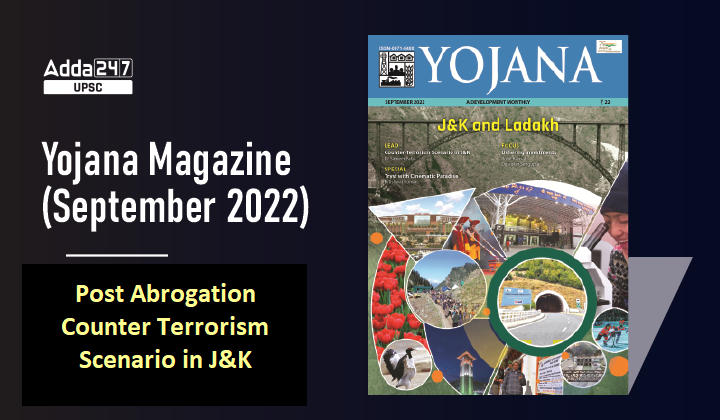Table of Contents
Yojana Magazine is a very important and indispensable source for UPSC Civil Services Exam Preparation. Here, we come with ”Analysis Of Yojana Magazine” which covers the monthly Yojana Magazine keeping in mind the demand of UPSC, particularly from the topics of important government schemes.
In ‘‘Analysis Of Yojana Magazine,” we cover each and every topic of the Yojana edition of a particular month and provide an easy-to-understand gist.
This topic-wise analysis is prepared from the Septeber 2022 edition of the monthly Yojana Magazine.
Introduction
- On August 5, 2019, in a significant move, the Government of India (GoI) abrogated Article 370, ending the semi-autonomous status of Jammu and Kashmir (J&K).
- With that, a pronouncement was also done to bifurcate the state into the two centrally-administered union territories (UT) of J&K, and Ladakh.
- Alongside, the government also decided to repeal Article 35A of the Constitution that defined the permanent residents’ status in the state. It may be recalled that this provision was inserted in the Constitution in 1954 through a Presidential Decree. These decisions signaled a new phase in Kashmir’s history, encouraging the people of the state a future of development and peace.
Is normalcy restored in J&K?
- Though the abrogation of Art. 370 is one of the game changing steps in the history of J & K to bring normalcy in Kashmir, yet things will take some time and continuous efforts.
- The fact today is that Kashmir, known for its intellectual pursuits, became home to stone-pelters, suicide bombers, hawala money, massive drug abuse, and caliphate ideology.
- It is enough to make even a lay observer understand the extent of psychological, sociological, and existential crisis which the Kashmiri society is undergoing.
- Hence the definition of ‘normalcy’ to a set of numbers like telephone lines restored, internet connections extended, political detainees released would be misleading.
What is stopping bringing normalcy in J&K?
- Reportedly, on November 21, 2019, after things seemed to return to ‘normalcy,’ valley-wide protests erupted with shut-downs and hartals.
- Posters released by militant organizations threatening the shopkeepers to keep the markets closed were put up in different parts of the valley, and some shops were also burnt.
- Pakistan’s terror, sabotage, and radicalization infrastructure are firmly entrenched in certain parts of the valley.
- And therefore, Kashmir cannot move towards full ‘normalcy’ unless there is a massive crackdown on Pak’s terror machinery in the state. For this to happen, political leadership should address broader issues.
Rising Attack on Civilians/target killings
After the restoration of post-paid phones on 14th October, four non-resident truck drivers and six Bengali laborers have died in terrorist violence. A grenade attack in Sopore on 28th Oct. injured 20 civilians. In the deadliest attack after the abrogation of Article 370, a grenade was lobbed in the Lal Chowk area of Srinagar on November 4, killing one person injuring many civilians.
Pak-supported terror groups
As the list of terror incidents grows, informed sources believe that Pak-supported terror groups are likely to:-
- Engage a high-value target or stage a hostage crisis.
- Launch Fidayeen and random grenade attacks.
- Try to create a united front of Khalistan (Sikh separatist movement) in Punjab and Kashmir resistance front, not only in militancy but also in global diplomatic platforms.
- Force markets shut down so that there is no return of normalcy.
What is the aim of militants?
- The long-term aim is to force a 1990-style migration of the local Hindu population to strengthen the Islamist and separatist constituency.
- There is also a likelihood of communal polarization and the resultant Hindu-Muslim riots in the Jammu region and other parts of the country.
- With the US withdrawal from Afghanistan, there is a possibility of Pakistan using Taliban fighters in Kashmir to keep the situation tense.
- As per the intelligence sources, Afghan terrorists have been spotted in Kashmir.
- Large-scale infiltration in the recent past indicates that Pakistan once again will rely more on better trained and resilient foreign terrorists from Punjab.
What should be our approach?
- The first and foremost approach should be to eliminate cruel demons(terrorists) with force like never before.
- The reassuring part is that those perpetrating targeted killings in Kashmir Valley are efficiently being hunted down by security forces and the local police
- There is a strong need to continue with the ongoing multi-dimensional crackdown on Pakistan-sponsored terror machinery comprising Islamist organizations, terrorist groups, media groups, and anti-national and Islamist charities.
- Kashmiris will definitely respond positively to private investment. So, the government should encourage large investment in Kashmir especially by strengthening security situations in the uncertain regions and the security situation.
- The Kashmiris need to be convinced that a business approach is in their best interest. Kashmiris have to reconsider their centrifugal tendencies like autonomy and militancy and learn from other nation-states in the world that are adopting a more rational approach.
Conclusion
One thing is clear that People in J&K have started realising that terrorists who claim to engaged in an “armed struggle” for ‘azadi’ [freedom] are actually “fighting Pakistan’s war in Kashmir”-fact that none other than United Jihad Council chief and Hizbul Mujahideen terrorist group supremo Syed Salahuddin has himself admitted. Rejection of violence by Kashmiris is a positive development that will certainly go a long way in ridding the Valley of the scourge of terrorism, which in the words of Mirwaiz Umar Farook has “not achieved anything other than creating more graveyards”!



 TSPSC Group 1 Question Paper 2024, Downl...
TSPSC Group 1 Question Paper 2024, Downl...
 TSPSC Group 1 Answer key 2024 Out, Downl...
TSPSC Group 1 Answer key 2024 Out, Downl...
 UPSC Prelims 2024 Question Paper, Downlo...
UPSC Prelims 2024 Question Paper, Downlo...
